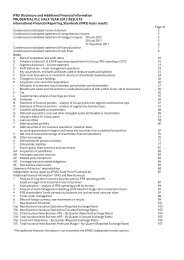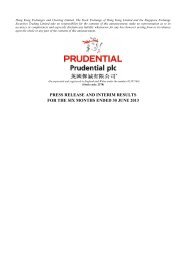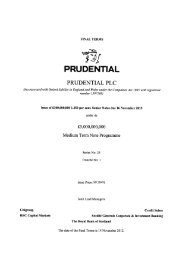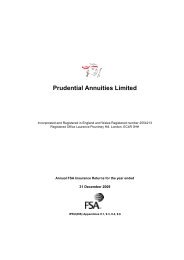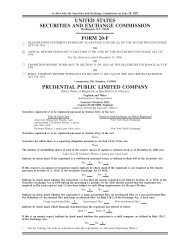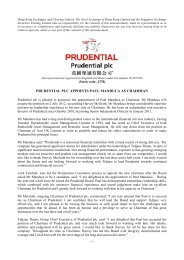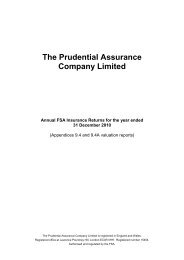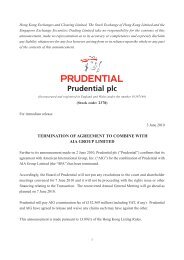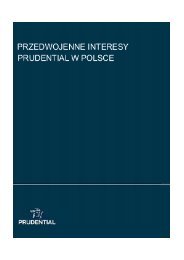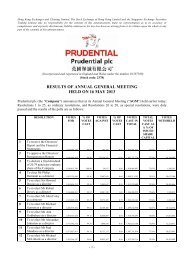ANNUAL REPORT 2001 - Prudential plc
ANNUAL REPORT 2001 - Prudential plc
ANNUAL REPORT 2001 - Prudential plc
Create successful ePaper yourself
Turn your PDF publications into a flip-book with our unique Google optimized e-Paper software.
However, we have not been discussing or<br />
considering any actual distribution of the<br />
inherited estate. Our current expectation<br />
is that, for the foreseeable future, the entire<br />
inherited estate will need to be retained<br />
within the long-term fund for the purposes<br />
described earlier.<br />
Any proposal which resulted in a portion of<br />
the inherited estate being attributed solely<br />
to shareholders would require the interests<br />
of policyholders in the inherited estate to be<br />
taken into account. Such proposals may or<br />
may not be made.<br />
Financial Strength of Insurance<br />
Operations<br />
A common measure of financial strength in<br />
the United Kingdom for long-term insurance<br />
business is the free asset ratio. The free<br />
asset ratio is the ratio of assets less liabilities<br />
to liabilities, and is expressed as a percentage<br />
of liabilities. The free asset ratio of the<br />
<strong>Prudential</strong> Assurance Company (PAC) longterm<br />
fund was approximately 12 per cent at<br />
the end of <strong>2001</strong>, compared with 17 per cent<br />
at 31 December 2000. The reduction during<br />
the year principally reflects the significant<br />
fall in equity markets around the world.<br />
The statutory valuation has been prepared<br />
on a conservative basis in accordance with<br />
the valuation rules, and without use of<br />
implicit items. No allowance has been taken<br />
for the present value of future profits and<br />
the PAC long-term fund has not entered into<br />
any financial reinsurance contracts.<br />
Solvency requirements in the UK include the<br />
establishment of a resilience reserve which<br />
makes prudent allowance for potential<br />
future movements in investment values.<br />
The Financial Services Authority (FSA)<br />
relaxed the recommended resilience tests<br />
in September <strong>2001</strong> in response to the<br />
changing economic conditions and extreme<br />
market movements at that time. Pending<br />
the outcome of FSA consultation on the<br />
resilience tests that should be applied in<br />
the future, we have applied the rigorous<br />
resilience tests previously specified by the<br />
FSA (prior to September) in line with the<br />
tests we adopted in 2000. As at 31 December<br />
<strong>2001</strong>, the overall liability was based on the<br />
following combined resilience scenario:<br />
• a fall in equity values of 25 per cent;<br />
• a fall in property values of 20 per cent;<br />
• a fall in bond values of 17 per cent<br />
(consistent with an increase in interest<br />
rates of three per cent).<br />
The long-term funds remain well capitalised<br />
and the PAC long-term fund is rated AAA by<br />
Standard & Poor's and Aaa by Moody's.<br />
At 31 December <strong>2001</strong>, 69 per cent of the<br />
assets of the fund were held in equities and<br />
property, including 15 per cent in international<br />
equities, 15 per cent in property and 39 per<br />
cent in UK equities. This reflects our strategic<br />
asset allocation of the fund between equities<br />
and other classes of assets and represents a<br />
switch over the last couple of years away from<br />
equities into investment grade bonds. The<br />
fund had an investment return of negative<br />
3.5 per cent in <strong>2001</strong>. This compares to a fall<br />
in the FTSE all-share index of 15 per cent<br />
over the same period and represents a strong<br />
investment performance from M&G and from<br />
our fund managers in America and in Asia.<br />
The capital adequacy position of Jackson<br />
National Life remains strong with a risk<br />
based capital ratio of 296 per cent of the<br />
regulatory minimum. As a core business to<br />
the Group, JNL’s financial strength is also<br />
rated AAA by Standard & Poor’s. Adequate<br />
solvency levels have been maintained by<br />
our insurance operations in Asia.<br />
Recent Accounting Pronouncements<br />
In December 2000, the Accounting<br />
Standards Board published a new<br />
accounting standard, FRS 19, ‘Deferred tax’,<br />
which replaced SSAP 15. We adopted the<br />
new standard early and have restated our<br />
2000 comparatives accordingly. The<br />
adoption of the new standard has had a<br />
limited impact on our shareholder results.<br />
On the statutory basis, profits after tax and<br />
minority interests for 2000 after restatement<br />
fell from £688 million to £657 million and<br />
shareholders’ capital and reserves at<br />
1 January <strong>2001</strong> fell by £49 million to £3,971<br />
million. The main impact has been on the<br />
fund for future appropriations where,<br />
on a restated basis, additional deferred<br />
tax principally on unrealised investment<br />
appreciation of £2,350 million was<br />
established at 31 December 2000. This<br />
has no impact on shareholders’ funds.<br />
While FRS 17, ‘Retirement benefits’, only<br />
comes fully into effect for periods ending on<br />
or after 22 June 2003, certain disclosures are<br />
required for our <strong>2001</strong> financial statements.<br />
When fully implemented, the standard will<br />
require that companies include the whole of<br />
any pension surplus or deficit of defined<br />
benefit schemes in their balance sheet and<br />
has changed the way in which pension<br />
surpluses and deficits are valued. In<br />
particular, it requires assets of the scheme to<br />
be valued at their market value at the<br />
Company's year end, while pension liabilities<br />
are required to be discounted at a rate<br />
consistent with the current rate of return on<br />
a high quality corporate bond. Despite<br />
adverse market conditions our three main<br />
staff schemes (the <strong>Prudential</strong> Staff Pension<br />
scheme, the Scottish Amicable Staff Pension<br />
scheme, and the M&G Group Pension scheme)<br />
all remained in surplus for the year ended<br />
31 December <strong>2001</strong> on the FRS 17 basis.<br />
The aggregate surplus before deferred tax<br />
provision, representing prepaid contributions,<br />
attributable to the Company at the year end<br />
was £585 million (£441 million attributable to<br />
the PAC with-profits fund, and £144 million<br />
attributable to shareholder financed<br />
operations). The disclosure required by<br />
the accounting standard is incorporated<br />
in note 19 on page 62 of the full financial<br />
statements.<br />
PRUDENTIAL ASSURANCE COMPANY<br />
WITH-PROFITS LIFE FUND ASSET DISTRIBUTION<br />
UK Equities 38.5%<br />
Alternative Assets 1.6%<br />
International Equities 14.8%<br />
M&G Fixed Interest 19.4%<br />
PPMA Fixed<br />
Interest 8.4%<br />
Property 14.9%<br />
Cash 2.4%<br />
19 <strong>Prudential</strong> <strong>plc</strong> Annual Report <strong>2001</strong>



